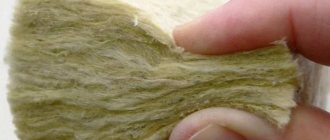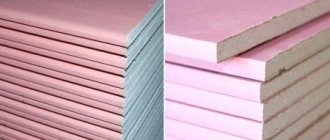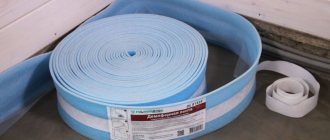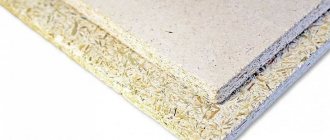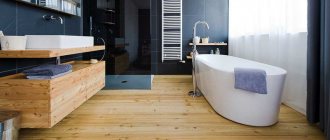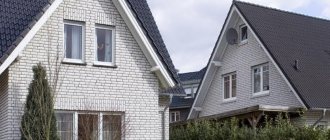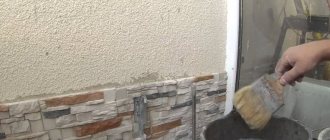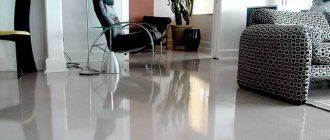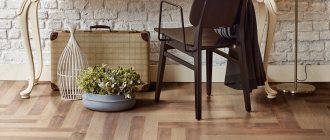Before laying most finishing coatings, such as laminate, linoleum or carpet, the floor surface must first be leveled. An excellent solution in such cases would be to use gypsum fiber sheets. This finishing material is made of gypsum; the reinforcing element in these sheets is loose cellulose fibers and various technological additives. GVL sheets are distinguished by the absence of a shell, homogeneity of structure and higher density and strength than plasterboard.
GVL for floors
The most important advantages of this material are environmental friendliness and non-flammability.
What it is
Often, when choosing a finishing material, the consumer has the question of what is gypsum fiber board for the floor. As the name suggests, it is a gypsum fiber sheet. However, unlike the standard well-known drywall, it does not have an outer paper shell. The structure of the slab is homogeneous. The basic necessary properties are given to it during the following production process:
- The main components - gypsum, cellulose and various modifiers are mixed evenly.
- The mixture is filled into the form.
- The workpiece is saturated with water and fed into the press installation.
- The formed slab is dried - the material is brought to a certain degree of humidity.
- The finished product is transferred to the warehouse.
Another important difference between the material and conventional drywall is its higher strength, water resistance and density. Thanks to this set of properties, the GVL slab is used not only and not so much for finishing, but as a substrate for a coating, for example, laminate or parquet, and also as a rough version of the floor and even as a sound insulator.
GVL close-up Source company-megapolis.rf
Why gypsum fiber board?
What is GVL? Essentially the same drywall, only improved. Gypsum fiber boards have more advantages than gypsum boards. The material has high strength characteristics, is moisture-resistant and fire-resistant. According to these characteristics, it is in many ways superior to plasterboard, therefore it is more often used as a base for a tiled floor. Another advantage that distinguishes gypsum fiber board from gypsum plasterboard is the excellent strength of the material, which allows the slabs to be used when arranging a flat floor covering using the dry screed method. Hypo-fiber slab
If the tiles are laid in the bathroom, then special gypsum fiber sheets, which are moisture resistant - GVLV - are laid as the base for the tiles. The technology for laying gypsum fiber flooring under tiles will not present any difficulties; the main thing is to follow the technology and recommendations of specialists. Below are some useful tips from experienced tilers, they will help with tiling work. GVLV slab is a reliable basis for laying tiles in wet rooms
Characteristics and features of the material
Gypsum fiber panels have a lot of parameters that set them apart from other sheet products:
- Strength. The homogeneous structure ensures high performance. This is explained by the composition: gypsum and cellulose fibers, which give a reinforcing effect.
- Viscosity. Elements can be processed in various ways: sawing, milling, etc., this will not damage the structure or deform the parts. It is due to this that a good result is achieved when installing a heated floor.
- Fire safety. The product does not support the spread of fire, which allows the slabs to be laid on various communication systems.
- Low thermal conductivity. The resulting gypsum fiber surface can be used as additional insulation. But this significantly complicates the process of installing a heated floor, since the system has to be literally built into gypsum fiber board sheets.
- Wide range of applications. The slabs are suitable for concrete and wood bases, as well as for dry screeding. The sheets are relatively light in weight, so they do not put a significant load on the base. The material can be laid with your own hands without the involvement of specialists.
Gypsum fiber sheet, compared to its main competitor - gypsum plasterboard, has improved characteristics
Gypsum fiber includes two main groups of products used for flooring on horizontal bases: the standard version and moisture-resistant gypsum fiber board for flooring - GVLV. The resulting floor covering will be reliable and durable, but only if the variety is chosen correctly.
Unlike conventional gypsum plasterboard, moisture-resistant sheets incorporate a fiberglass reinforcing mesh
Application area
Taking into account its versatile qualities, GVL can be called a universal building material. The following areas of application exist:
- Formation of dry floor screed.
- Use as a lining under the finishing coating - linoleum, parquet, etc.
- Creation of interior partitions.
- Construction of a subfloor on a wooden sheathing over a concrete floor.
- GVL flooring sheets can be part of the heat or sound insulating layer of various house structures.
- Installation of a heated floor system.
- Design of fireproof communication boxes.
- Formation of fire-resistant surfaces in bathhouses and boiler rooms.
- Creation of moisture-resistant finishes in bathrooms, saunas, showers.
Advice! When choosing GVL, first of all, it is necessary to take into account the operating conditions. For example, for a bath or sauna, an option with increased resistance to water and fire is suitable.
GVL partitions indoors Source guruotdelki.ru
Insulation under GVL
There are three main types of insulation under GVL:
- Dry backfill made of expanded clay or crushed slag stone made on a concrete or wooden base.
- Thermal insulation layer made of polystyrene foam or expanded polystyrene. Can be laid on a concrete base or as an additional layer on expanded clay.
- Glass or mineral wool slabs laid on a wooden or concrete base between joists.
Figure 6. Mineral wool for floor insulation in a wooden house.
Characteristics
Standard gypsum fiber sheets for flooring are characterized by the following parameters:
- Strength – does not exceed 1.2 thousand kg/m³.
- Density – over 5.5 MPa.
- Humidity – less than 1%.
- Hardness index – 22 MPa and more.
- Thermal conductivity value is from 0.22 to 0.35 W/m × °C.
The dimensions of the standard plate are within the following values:
- Length – 250 cm.
- Width – 120 cm.
- Thickness – 10 mm.
In this case, the values of physical parameters may be different - depending on the wishes of the customer or the characteristics of production. For example, small-format versions are available in sizes 120 by 60 or 150 by 50 cm.
Types of GVL
Gypsum fiber sheets are produced in the usual form - GVL, and moisture-resistant - GVLV, impregnated with hydrophobic primers.
They can be distinguished by markings on the sheets.
Marking example: GVLV-B-FK-1500*500*15 means:
- GVLV - the symbol “B” indicates the moisture resistance of the sheet:
- "B" - manufacturing accuracy. Marking "A" means high accuracy of the sheet. The symbol “B” indicates that the sheet was made with large deviations.
- FC - folded edge. PC stands for straight edge. Sheets with a straight edge are used for leveling floors, while sheets with a folded edge are used for walls.
- 1500*500*15 - length, width and thickness of the sheet.
Conventional sheets are used in dry residential areas where there is no risk of leaks. Moisture-resistant sheets are used in damp and unheated rooms.
Standard sizes of gypsum plasterboard for flooring:
- length 1500 and 2500 millimeters;
- width 1200 and 1000 millimeters;
- thickness 10 and 12 millimeters.
Figure 2. Standard sizes of GVL.
Prefabricated floor elements are produced in standard sizes of 1500*500 millimeters. The thickness of gypsum plasterboard for prefabricated floors is 200 millimeters. The sheets have folds for fastening the elements together.
Figure 3. Prefabricated floor elements.
Manufacturers also produce other sizes of slabs according to consumer orders.
Varieties
Gypsum fiber boards of the type in question differ primarily by area of application into the following categories with appropriate markings:
- Standard - GVL . For ordinary premises.
- Moisture resistant - GVLV . For humid environments.
- Fire resistant - GVLO . With increased fire resistance.
- Moisture-resistant - GVLVO . For finishing in areas with high air humidity and elevated temperatures.
GVL for the "warm floor" system Source pol-exp.com
GVL, classified as fireproof, are classified into the following subcategories:
- Non-flammable - G1.
- Do not produce smoke when burning - D1.
- Non-flammable - B1.
- Low toxic - T1.
Due to the fact that it does not support the combustion process, the material is recommended for covering wooden structures of all types - when building houses using frame technology, creating partitions or finishing in wooden structures, including subfloors on joists made of boards or bars.
Note! GVL floor slabs allow not only leveling the surface, but also effectively insulating walls and ceilings from sound and saving heat in the room. At the same time, the structure of the material does not interfere with the passage of air and moisture, and therefore ensures a healthy microclimate in the house.
Finishing a house from GVL Source stroy-podskazka.ru
See also: Catalog of companies that specialize in finishing materials and related work
Tips for using gypsum fiber sheets
Experts recommend adhering to the following tips when leveling the GVP floor:
- Trimming gypsum fiber boards is best done with an electric jigsaw. You can use other available tools, but this tool will make the edges perfectly smooth and straight.
- To prevent the sheets from sagging during operation, you need to cut off the folded edge of the sheets that are located close to the walls.
- Poorly glued slabs are not monolithic enough and make a ringing sound when walking, so the folds need to be covered with a generous amount of glue.
- Screw the self-tapping screws to a depth of at least 1 mm. If they stick out strongly on the surface, the sheets become deformed when walking.
- Only dry amorphous insulation should be used. Moisture from expanded clay will be absorbed by the gypsum fiber, which can lead to its deformation.
The methods for leveling the GVP floor are approximately the same. You need to choose high-quality sheets with waterproofing characteristics. Laying the material does not take much time and effort, and the surface after completion of the work will be smooth and durable.
Advantages and disadvantages
The formation of a number of material properties is determined by the production technology and the modifying components included in its composition. Thanks to this, GVL is homogeneous in structure, dense and has the following set of positive qualities:
- Possibility of installing any heating system under the casing - both electric and water.
- Minimum thickness with maximum strength, sound and heat insulation.
- The installation technology is all-season and is allowed at negative ambient temperatures - since it does not include work with wet mixtures and solutions.
- The combination of strength, flexibility and high density properties, which greatly facilitates installation while maintaining useful performance characteristics.
- Moisture-resistant gypsum plasterboard for floors is significantly superior to plasterboard in its resistance to moist air and direct contact with water splashes. It can be installed in rooms where water splashes fall on the floor.
- The structure of the material does not change even after strong heating.
- After installation, the slabs do not creak.
Scheme for laying gypsum fiber board on the floor Source chudopol.ru
- Thanks to the combination of strength and elasticity, the surface can withstand heavy weight, shock and various mechanical loads.
- The material's high resistance to elevated temperatures prevents the spread of fire and prevents fires.
- Thanks to the fibers included in the composition, the material does not collapse during sudden temperature changes.
- In terms of areas of application, the material has virtually no restrictions or contraindications.
- High level of environmental cleanliness. Contains only natural and safe ingredients.
However, with all the obvious advantages and superiority over conventional drywall, gypsum plasterboard is not without some disadvantages:
- High specific density, significantly heavier product. So, just one standard sheet weighs about 17-18 kg. This complicates the installation procedure. More workers are needed.
- Despite the high levels of operational flexibility, the product is not without practical fragility. If installed improperly, the sheet can easily be broken or crumbled, especially at the edges and corners.
GVL slabs break easily during installation Source ekb-pol.ru
Advantages and disadvantages
Advantages:
- Moisture resistance. Hydrophobic additives are always added to the material during production, so slight contact of gypsum fiber board with water is not harmful to it.
- Withstands high loads. The material does not bend, crack, or deform when pressed against it by heavy objects.
- Flexibility. Leveling of various impacts occurs with almost any type of difference in loads.
- Environmental friendliness. The material does not emit any substances harmful to health. It can be laid in living areas where there are small children.
- Fire safety. High temperatures are not scary. In this case, combustion is not accompanied by the release of harmful substances.
- Soundproofing to reduce the audibility of noise in the room.
- Waterproofing. Due to the fact that the material is not susceptible to water, it perfectly retains moisture and prevents it from seeping down to the first floors.
- Frost resistance. Can withstand up to 15 freeze/thaw cycles.
Attention
Due to its frost-resistant qualities, GVP can be laid in unheated rooms. Temperature changes will in no way affect the quality of the flooring.
Negative qualities of SHG:
- Heavy weight. Therefore, slabs can only be laid on solid foundations.
- Constant monitoring of correct installation is required. All actions with sheets must be performed strictly according to the instructions. Any deviation from the fundamental rules will lead to deformation of the entire structure.
- High price. The material is not as common as, for example, chipboard. This explains the inflated cost per square meter.
Installation technologies
Despite the apparent simplicity of the material, the procedure for installing gypsum fiber boards is quite complex and has many nuances. It is necessary to take into account both general requirements for the base and specific ones - in each installation option. Let's look at them in more detail.
Laying gypsum fiber board on an expanded clay cushion Source sense-life.com
General requirements for foundation and installation
The versatility of GVL slabs is also evident in the installation methods. They can be mounted either on a solid, level base or on beams with a sufficiently large gap from each other. At the same time, special requirements are imposed both on the surface on which the material will be laid, and on the material:
- The height difference should not exceed more than 2 mm for every 2 meters of the straight line of the base.
When laying soft finishing - linoleum, vinyl, carpet - small and shallow unevenness is allowed. However, leaving such defects for installation of parquet or laminate is extremely unacceptable. At a minimum, this threatens the subsequent spreading of the finish and the divergence of its locks.
- When installing on a non-solid base or on joists/lathing, it is necessary to use gypsum fiber boards of increased density and maximum thickness.
As an option, laying sheets in 2 layers is allowed. In this case, the modification of the material must necessarily be GVLV - moisture resistant, and the seams of the lower layer must be covered with the top sheet.
Laying gypsum fiber sheets on joists Source blogspot.com
- Immediately before laying, the ends of the slabs must be glued - coated with an adhesive base.
If installation takes place on a rigid base, for example, a concrete floor, it is allowed to use PVA, and if on joists or insulation, a sealant that retains elasticity after complete drying is allowed.
Important! The gaps between the gypsum fiber board sheets after installation should not exceed 1.5-2 mm. If the finishing has a soft base, then even smaller gaps between the slabs must be puttied.
Step-by-step instructions for installing gypsum fiber board floors
Step 1
Before installing the gypsum fiber board floor, you should dismantle the old floor covering, boards, fiberboard sheets and logs on which the old floor lay. We remove absolutely all old materials; in the end, bare floors should remain. Be sure to thoroughly sweep the surface, remove all construction debris and, if possible, dust.
Step 2
Floors that have been cleared of old materials and debris may have cracks and holes. They should be eliminated by pouring inside a quick-hardening cement mortar with a marking of at least 150 or covering it with a mounting mixture. Alabaster is also suitable for this purpose.
Step 3
For marking you will need a laser level
It is necessary to mark the top level of the backfill. For this stage of work you will need a laser or water level. The height of the marks can vary from 2 to 6 cm. This range depends on the unevenness of the floors. As a result, the base floor will be located 2 cm higher, since the thickness of the double sheet of gypsum fiber board will increase.
Marking
Step 4
The floors are completely ready for waterproofing. The entire surface should be covered with plastic film if the floors are concrete, but glassine and bituminized paper can be laid on a wooden surface. Sheets of waterproofing material should overlap, overlapping each other by 20-25 cm. The edges must be glued with mounting tape.
The film should extend onto the walls and its edge should be located at least 2 cm above the level marks. Attach the waterproofing to the walls with mounting tape.
Film laying
Step 5
If communications will be located on the floor of the gypsum fiber line, then all wires must be carefully hidden in a protective corrugation and fixed to the floor. It is important to consider that between the corrugation with wires and the gypsum fiber boards there should be a layer of expanded clay no thinner than 2 cm. If necessary, adjust the height of the marks.
Step 6
Edge tape
To eliminate the appearance of so-called sound bridges, there are two options. You can glue the perimeter of the room with foam rubber edge tape 10 cm wide and 1 cm thick. To increase the speed of work, we recommend purchasing self-adhesive tape; if you don’t have it, fix a simple foam tape with mounting tape.
You can also use edge tape made of mineral wool or polyethylene foam for sound insulation. These materials perfectly perform the function of protecting the finished floor from deformations that can be caused by thermal expansion.
After laying the soundproofing tape is completed, it is necessary to cut off the excess, focusing on the top floor, including the level of backfill and the thickness of the gypsum fiber board slab.
Step 7
We begin filling the expanded clay. Carefully sprinkle expanded clay with a fraction of no more than 0.5 cm onto the vapor barrier layer. Be sure to wear a respirator, since when expanded clay is poured out of the bags into the air, a large amount of dust will inevitably rise.
expanded clay
Step 8
The next step is to level the expanded clay using metal profile guide beacons. Be sure to use a level when performing this operation. If you use a water level, then when calculating the distance between the profile, be guided by the length of the level. The ends of the tool should lie on adjacent guides, which will subsequently serve as a guide and support for the rule. Some craftsmen find it convenient to use a water level instead of a rule. This technique gives additional control over the thickness of the expanded clay layer. Level the backfill layer meter by meter.
Pay special attention to compacting material near walls, in doorways and in corners of rooms. Perform this work only in a respirator to prevent dust from entering the respiratory tract.
Expanded clay backfill
Leveling dry backfill
After completing this stage of work, be sure to remove the guides and fill the resulting voids with expanded clay. In order not to deform the leveled and compacted expanded clay, use GVL sheets as special “islands”. However, any similar materials are suitable for this purpose. For example, waste fiberboard or plywood. The size of the islands should be no less than 50x50 cm.
Step 9
Additionally, the floor can be insulated and soundproofed; for this purpose, sheets of plasterboard and penoplex are laid under the gypsum plasterboard
Additionally, the floor can be insulated and soundproofed; for this purpose, sheets of plasterboard and penoplex are laid under the gypsum plasterboard
Layout starts from the far corner of the room
Joints are glued during installation
Laying gypsum fiber sheets
You should start installing gypsum fiber boards from the corner located farthest from the door. This will eliminate the possibility of damage to the leveled dry expanded clay screed. The edge of the sheet located against the wall should rest against the edge tape. The seam edges of adjacent slabs must be coated with PVA glue to obtain a strong “lock”. Then, every 10-15 cm, it is necessary to screw in self-tapping screws at least 2 cm long. Thus, the perimeter of each sheet will be strengthened in two ways.
Screwing in self-tapping screws
When laying the second row of gypsum fiber boards, move the joints so as to obtain the effect of brickwork. Use a jigsaw to adjust the slabs to size.
In cases where the floor base in the room is very uneven and the thickness of the expanded clay layer is from 6 to 10 cm, it is necessary to lay a second layer on top of the first layer of gypsum plasterboard sheets. When laying the second layer, work should begin from the corner opposite the entrance to the room. Carefully ensure that the seams between the slabs of the first and second layers do not coincide and do not overlap each other.
Finished work. Smooth and durable floor
Step 10
When laying the gypsum fiber board floor is completed, you need to putty the seams between the sheets and the places where the screws are screwed in. Additionally, you can use reinforcing tape. When laying gypsum fiber board floors in the bathroom and kitchen, it is worth using special products for waterproofing joints with walls and seams between sheets.
You can begin laying the final floor covering a day after finishing work with gypsum plasterboard slabs, during which time the glue and putty will have time to dry. On top you can put tiles, laminate, linoleum or any other covering. If necessary, use a specialized substrate.
You can immediately lay laminate on a GVL floor
Video description
Video instructions for creating sound insulation from GVL on a concrete floor:
Laying on a wooden floor
Installation of gypsum fiber sheets on a wooden floor or joists must be carried out with leveling the surface and subsequent checking the level, as well as with preliminary antiseptic treatment of all wooden structures.
Often, the option under consideration involves laying gypsum fiber board on a wooden floor under the tiles. Then, after fixing the material, a special glue under the ceramics is applied to its surface, and then its stage-by-stage installation is carried out. In this case, there is no need to fill the gaps formed between the sheets during installation - since the adhesive base seals them.
Prefabricated Flooring on Cushion
Often, to level the surface with large differences in height or to give the ceiling maximum thermal insulation, granular materials are used, for example, expanded clay. The main advantage of the method is the maximum speed of installation and the absence of the need to work with solutions. In addition, this filler is quite lightweight and can be used on a wooden base.
Some information about the use of the material
In order to correctly lay gypsum fiber board on the floor, you need to know some nuances that will ensure an excellent final result of the work. For example, special sheets with a thickness of 10 mm are produced for floors - it is better to use them. Before laying gypsum fiber board sheets, it is important to pour a layer of expanded clay onto the base. It will provide additional leveling of the floor and help insulate the base. This is the most accessible and cheapest option. The optimal size of expanded clay fractions is 5 mm.
Types of backfill for dry floor screed
Also, guides are mounted on the base, which play two roles:
- guideline when adding base . In this case, expanded clay is poured to the edges of the guides, compacted and leveled using a long rule;
- support for gypsum fiber sheets . The installation will be more professional if the material has support and places for fastening.
Leveling the bedding layer
If the installation of gypsum fiber boards will be carried out on a wooden base, then it is important to properly prepare such floors beforehand. Preparation includes checking the floorboards for strength and, if necessary, replacing them. The floor is screeded if there are significant gaps between the individual elements. Although some craftsmen do not screed, arguing that if there are cracks, the floors will be better ventilated. So you can avoid this stage.
Also, GVL sheets on a wooden base must be laid in two layers, which will make the base reliable and durable. GVL sheets are usually mounted on wood if it is necessary to lay a floor covering that is demanding on the evenness of the base - for example, ceramic tiles, laminate. In other cases, the wooden base may not be leveled. The gypsum plasterboard layers are fixed in the following way: the first one is attached with self-tapping screws, and the second one is mounted on the first one using PVA glue (in this case, excess glue protruding between the seams is immediately removed). However, it would not be a bad idea to secure it with self-tapping screws. The two layers must be laid apart so that the seams do not coincide with each other. You need to move the sheets by about 20-30 cm. This will ensure that the base is as strong as possible.
Dry floor screed
Important! When laying gypsum fiber board sheets, it is important to ensure that the gaps between the sheets are not more than 2 mm. Also, if laminate or carpet is used as the finishing coating, the cracks must be puttied.
And one more condition that must be met during the installation of gypsum fiber board sheets if they have folds. At the extreme row, located near the walls, they should be trimmed. Moreover, trimming is done on already laid sheets.
Adapted dry screed Knauf
How to make a dry screed with perlite
Dry screed using German technology
Dry screed with vermiculite
Calculator for calculating expanded clay backfill for dry screed
Go to calculations
Prices for GVL from
GVL Knauf
Video description
Video about installing gypsum plasterboard on expanded clay:
In this case, a lathing must be created to fix the gypsum fiber. Its depth will correspond to the thickness of the backfill layer. An important feature of using this method is maintaining a gap around the entire perimeter of the room - between the slabs and the walls. Its presence is due to the need for ventilation and the natural vapor permeability of wooden structures.
Laying tiles on GVL
In rooms with high humidity, tiles are usually installed using gypsum fiber board. In this case, the following conditions must be met:
- The floor must have additional waterproofing.
- If the slabs are laid on logs or a base made of boards, they should not sag during operation.
- It is necessary to use elastic glue as a fastening base for ceramics.
- The seams of the laid tiles and gypsum fiber sheets should not match.
Note! An improperly prepared base can cause poor-quality installation of gypsum fiber boards and their subsequent damage during operation. The smallest grains of sand, dirt stuck in cracks, and hidden irregularities can cause significant defects in the floor in the near future after its completion.
In what cases is it appropriate to use gypsum fiber boards?
Decorating the floor with gypsum fiber boards is appropriate for creating a screed in any room. First of all, this will help reduce the pressure on the floors. For comparison, you can take a self-leveling floor. Firstly, you will have to purchase a large number of materials, such as cement, gravel and sand. Secondly, you need to wait a few days before starting installation of the finishing coating. Thirdly, the weight of the screed will be at least 100-150 kg per m², which is especially important if we are not talking about the first floor. We should not forget that to complete all the steps you will probably need a concrete mixer, which is not so easy to carry to the upper floors.
Based on the listed facts, it becomes clear that gypsum fiber is an excellent alternative to self-leveling flooring, which allows you to avoid such difficulties and speed up construction and repair work. In addition, it is appropriate to use gypsum fiber board for flooring under tiles and other flooring options.
Gypsum fiber sheets can be used not only for leveling the floor, but also for insulation
Helpful advice! For a warm water floor, GVL is not an obstacle. The sheets fit well on top of the system, you just need to be careful not to damage the communications during installation.
If additional insulation of the surface is required, fibrous polystyrene foam or fill-in-fill insulators are used. Most often, expanded clay is used for this, which has good characteristics and low cost.
Briefly about the main thing
Gypsum fiber boards are made from gypsum, cellulose and various fillers. They have a homogeneous structure, do not contain cardboard and are highly durable and moisture resistant.
Laying gypsum fiber board on the floor has the following purposes:
- Dry floor screed.
- Lining for finishing coat.
- Interior partitions.
- Rough floor.
- Heat and sound insulation.
- Formation of heated floors.
- Creation of fireproof structures and surfaces.
- Moisture resistant finish.
In this case, GVL can be standard, moisture-resistant, fire-resistant and moisture-fire-resistant. Gypsum fiber boards are durable, resistant to temperature changes, do not burn, are environmentally friendly, resistant to mechanical and weight loads, but require careful installation, are quite heavy and expensive.
They can be mounted in various ways - on a concrete base, wooden floor or logs, in a prefabricated structure on a pad of insulation and under ceramic tiles. The installation procedure is quite complex and requires strict adherence to technological requirements. Therefore, it is better to entrust it to professionals.
Ratings 0
Preparing the base
Laying fiberboard boards to level the base
In the case where gypsum fiber sheets will be laid on a wooden floor, careful preliminary preparation of the base is necessary. Similar preparation is carried out when laying any sheet materials (chipboard, CBPB, etc.).
First, the condition of the floor is assessed. To do this, you need to remove the boards and inspect the entire structure.
Most often, GVLV are affected by rot. Regardless of the type of rot, the affected areas become softer. You can check the condition of the wood as follows: drive an awl into a place that differs in structure or color. If the instrument enters easily, the area is affected. Small fragments are removed; in case of significant damage, the structural element is completely replaced. Next, all wooden parts must be treated with an antiseptic composition.
Depending on what kind of finishing coating will be used, additional installation of joists may be necessary. The next stage of work on preparing floors is checking their construction level and leveling. In some cases, unevenness can be corrected by adjusting the joists: the excess is removed with a plane, and wedges are installed or bricks are placed to raise the floors.
Leveling the surface of the floor boards is carried out in the same way as when laying fiberboard. First, you need to deepen all protruding heads of nails or screws. Then the surface is checked with a level, and all bulges are removed with a plane or grinder. The cracks and chips are sealed with putty. Fine expanded clay can be poured into depressions more than 2 cm deep.
Features of wall mounting
When installing on a wall, a vertical sheathing of 20 cm thick boards is placed on it, leveling out all the unevenness. To do this, pads are added to the “dips” and the protrusions are trimmed off. It is advisable to select the installation step of the sheathing strips so that the joints fall on them. If this fails, a lining (a piece of board, plywood, chipboard - depending on the required thickness) is installed at the junction of the two slabs so that the joint does not dangle.
Not everyone wants to do sheathing. It's wrong, but that's how they do it
The installation of the slabs proceeds across the sheathing - the long side is laid on the floor, with the tenon facing up. This makes it easier to achieve minimal gaps at horizontal joints. Vertical ones will have to be dealt with in the manner described above - using a piece of chipboard with a groove and a rubber mallet. The installation pitch of the screws is the same: 15-20 cm around the perimeter of the slab and 20-25 cm along the intermediate strips.
Finishing work on installed tongue-and-groove chipboard
Manufacturers claim that the Quick Dec surface does not require putty. You can immediately glue wallpaper, paint, lay tiles, or apply decorative plaster on it. This is true about plaster and tiles. Only pre-treatment with impregnation is needed for better adhesion. For tiles you need to use a good adhesive.
You still have to putty, even though the amount of work is incomparable...
Under thin or smooth wallpaper, and especially under painting, the seams must be sealed. They are still visible. Under some types of wallpaper, the seams may not stand out, but before painting you will definitely have to putty.
Application of panels in construction
Laying gypsum fiber board on the floor
Installation of a “dry” slab floor is quick and simple.
Work order:
- Cover with waterproofing.
- Apply edge tape around the perimeter of the room.
- Lay a layer of expanded clay with a fraction of no more than 0.5 cm.
- Installation of the 1st layer begins from the wall opposite the door.
- The laid row on top is covered with glue, and the 2nd row is covered.
- Seal the joints.
- Lay the finished floor.
If the GVL is 1200x1500 in size, use the bricklaying method.
Builders call the technology waste-free; the trimmings are transferred to the next row. GVL is connected depending on the size. All products are glued. Large formats are secured with screws over the entire area every 30 cm, small ones - every 20 cm.
Small sizes are suitable for household purposes, since large products are inconvenient to work with.
Laying gypsum fiber board on the floor
For wall decoration
There are frame and frameless methods for installing sheets. Moisture-resistant GVL is used for wall finishing. With the frameless method, GVL is installed as follows:
- Gypsum putty is applied to the sheet in a thin layer and glued to the wall. This method is used when the unevenness of the walls is no more than 4 mm.
- If the wall error is 5–20 mm, glue is applied from the middle to the edges.
- GVL strips are installed on uneven walls (error is more than 20 mm). Only after this is the gypsum fiber material installed.
With the frameless method, preparatory work is carried out. The walls are cleaned of plaster, paint, dirt and primed. Level horizontal and vertical surfaces.
To prepare the solution, take the required amount of water. Then the mixture is poured into water and mixed thoroughly. Maintain a technological pause for 5–10 minutes and mix again. The thickness of the applied plaster layer should not exceed the recommended one.
The slabs are mounted on a frame when the walls are uneven. The sheathing is made of timber, metal profile. The walls must be prepared: cleaned and primed.
GVL Knauf
GVL installation stages:
- Markings are applied with a profile pitch of 50 – 60 cm.
- Install hangers.
- Mount the racks.
- Check the level.
The gypsum fiber board is screwed around the entire perimeter so that there is no deformation of the material.
GVL products differ from gypsum plasterboard in density, sound absorption, and fire resistance. The sheets have different structures, which determines their performance characteristics.
Gypsum fiber material is used for floor surfaces, walls and partitions. According to their properties, products are divided into GVL and GVLV.
Moisture-resistant GVLV sheets are used in kitchens and bathrooms. Installation of gypsum fiber boards and gypsum boards on the frame is absolutely the same.
Gypsum fiber sheets - clean work, dry screed
Well-known among builders, sheets with the abbreviation GVL are modernized descendants of materials that were once called “dry plaster.” In the production of durable solid sheets, cellulose fluff fibers are used, which act as a reinforcing component, and gypsum. The material resulting from semi-dry pressing is distinguished by excellent technical qualities: excellent load-bearing capacity, absence of bending deformation, combustion resistance, low thermal conductivity.
GVL floor installation - clean, easy, convenient
The list of advantages is complemented by important technological advantages:
- simple, quick installation of gypsum boards on the floor;
- no waste, which is especially attractive for budget-conscious owners;
- the ability to lay the finishing coating almost immediately without waiting a long curing period, as is required when installing a floor with a cement screed.
The main technological advantage of GVL is the ability to level the surface in an extremely short time without wet, dusty or dirty work.
Leveling gypsum fiber sheets are suitable for flooring:
- over concrete slabs and timber floors;
- on top of the leveling structure, for the construction of which logs were used;
- on top of polymer and sand-cement screed.
GVL floor improves the thermal characteristics of the room
The floor leveling element GVL, in addition to all its priorities, increases the insulating properties of the structure due to its excellent insulating properties. In addition, the material takes part in the formation of an optimal level of humidity for breathing. It absorbs vaporous water when there is an excess of it in the surrounding atmosphere and releases it back when there is a lack of moist suspension in the air.
Types of gypsum fiber sheets
For the construction of a prefabricated base, you can purchase two types of material; different types of gypsum boards for the floor are distinguished by the perimeter dimensions and thickness of the slabs:
- Standard gypsum boards resemble ordinary plasterboards. Their dimensions are regulated by GOST R51829-2001, they are 1200×1500 mm. This technologically advanced material is used not only for flooring, it is also used for leveling walls, forming partitions and creating a number of architectural elements.
- Small-format GVL. They are two sheets connected by gluing together with non-coinciding, intersecting central axes, shifted in two vector directions. Thanks to the displacement of one gypsum fiber sheet relative to another, a simple locking system is formed - a rebate, which facilitates the process of installation and connection of the elements of the leveling layer. They are produced in accordance with the requirements of technical specifications; small-format sheets are produced in two versions: 1200×600 and 1500×500 millimeters.
Standard Gypsum Fiber Sheet
Small-format gvl for the floor
Often, for the construction of two, three or more layers of a prefabricated base, sheets of equal sizes are used, but it is possible to use elements with different geometric parameters. For example, the first horizon from the insulating layer is laid using small-format elements, the second from large-format slabs, or vice versa. The main condition is that their directions do not coincide, since the installation and gluing of each layer must be done “in cross” to the previous one.
Specifics of laying GVL elements
A number of finishing and building materials manufacturers produce prefabricated leveling systems with a full set of sheets and fasteners for the construction of single and multi-layer leveling structures. Against the backdrop of the mass of offers from domestic and foreign manufacturers, products bearing the Knauf brand stand out. The international concern provides customers with instructions on how gvl floors are assembled.
A specific feature of the construction of a GVL floor is the uniform displacement of the panels, as a result of which the floor layer in plan resembles brickwork, thereby increasing the area of contact of each element with the sheets located next to it. This technology provides maximum strength.
Tools required for working with gypsum fiber boards
Many who independently prepared for installation and installed drywall mistakenly believe that they work with gypsum fiber board in the same way. But here an unpleasant surprise awaits them. Gypsum fiber sheets, for all their strength qualities, when you take them for a break, turn out to be fragile and break easily. By the way, this is why they cannot be bent like drywall.
Tools used to cut gypsum fiber sheets at home:
- A sharp construction knife with a thickness of 12 mm. The blades will have to be changed frequently as they become dull quickly.
- A special hacksaw for gypsum plasterboard, which can be used to cut this material almost without dust.
- A grinder or circular saw is used only in a well-ventilated area and provided that the end justifies the means. This is the fastest way and at the same time very dusty. If you decide to choose this tool, you will have to stock up on respiratory and eye protection.
- A jigsaw with a built-in vacuum cleaner is ideal if you install a wood saw with a tooth pitch of 4 mm in it. But there will still be a lot of dust, so you should work with safety glasses and a respirator.
Laying gypsum fiber board on the floor: preparing the material
To achieve maximum service life, gypsum fiber for floors must be subjected to an adaptation process, that is, left for 10-15 hours in the room where it will be used, therefore, they must be purchased and delivered in advance
This is very important, because during this time the sheets will get used not only to the temperature in the room, but also to the humidity level
In this case, you need to pay attention to the fact that the plasterboard floor must be made using special sheets intended specifically for floor coverings. If any questions arise, you should definitely consult with a specialist who will tell you which material is best suited and in what quantities
Technology for laying gypsum fiber moisture-resistant sheets
If the room is equipped with a good ventilation system, then the sheet (weight from 40 to 42 kg) is even laid on a concrete screed. For this, experts recommend choosing medium-sized slabs.
A sheet weighing 40 kg is suitable for laying on a wooden or reinforced concrete surface.
Follow the procedure for laying gypsum fiber moisture resistant sheets
Laying is carried out according to the following scheme:
- The floor is thoroughly cleaned of debris and dust. If there are cracks or similar defects, they are repaired.
- Polyethylene is laid, which protects the laid floor from moisture.
- The edge tape, which acts as a sound absorber, is laid out around the perimeter of the room. Columns and similar interior parts adjacent to the floor are covered with tape.
- Altitude beacons are set along which the guides will be placed.
- The guides themselves are laid and leveled - they will allow you to accurately level the insulation layer.
- Expanded clay is poured. It is compacted and leveled along pre-installed guides.
- Next, GVLV (whose weight does not exceed 40 kg) is laid starting from the corners of the room. After the first slabs are laid, they are fixed with an adhesive solution or mastic. Another layer of slabs is placed on top, the weight of which does not exceed 40 kg.
- The layers are connected to each other using screws.
- When the main installation work is completed, the floor is primed and the outer covering is installed.
GVLV sheet (weight - from 39 to 43 kg) is a new product in the field of repair, which is designed as an alternative to drywall, but without its weaknesses. Reinforcement with fluff pulp increases the technical characteristics of the material and makes its use for flooring or wall cladding more preferable.
What are gypsum fiber sheets: key characteristics
In appearance, gypsum fiber sheets are very similar to plasterboard, but their production technology is completely different. In both cases, gypsum is used for manufacturing, but if cardboard is used for gypsum board, then the key component in gypsum board is cellulose fiber, which is obtained by processing waste paper. In addition, gypsum plasterboard sheets are homogeneous, while drywall consists of several separate layers.
Cellulose fiber and gypsum are used to produce GVL.
Note! When choosing between gypsum plasterboard or plasterboard, you need to take into account that gypsum plasterboard is not used for flooring due to its fragility and insufficient strength.
The production of gypsum fiber (gypsum fiber) boards is regulated by the requirements of GOST R 51829-2001, so the use of the material is clearly regulated. According to the standards, panels can be used in private, public and industrial premises, including children's institutions. In addition to flooring, the sheets are suitable for cladding walls and ceilings. The material is perfect for pre-finishing, thus eliminating the need for plaster, putty and the use of liquid screed.
The composition of the sheets, in addition to gypsum and loose cellulose fiber, also includes latex, which not only gives the material strength, but also gives the panels moisture-resistant qualities. During production, all components are mixed together, after which the finished mixture is gradually diluted with water. The resulting dough-like mass is then fed to the press, where the finished slabs are formed. After pressing, the panels are dried. Some then go through a sanding process, while others remain as is.
Drywall: price per sheet, sizes, types of material (read more)
As a rule, treated slabs are more expensive and are used mainly for finishing floors and walls. GVL floor panels are not sanded, because a finishing coating is then laid on top of them - this can be tiles, laminate, parquet or even linoleum and carpet. The sheets can be mounted on joists or on a subfloor, on which all cracks and cracks are previously sealed. They can also be used in the case of a floating floor, as a material for dry screed, which does not require a long time to dry. Moreover, the material is considered suitable even for surfaces on which it is planned to subsequently exert significant loads.
GVL sheets are used not only for floors, but also for cladding ceilings and walls.
For the purpose of additional leveling, it is permissible to attach gypsum fiber boards to a wooden floor, concrete or cement base. It is important that the sheets not only level the surfaces, but also allow you to soundproof and insulate the floor. At the same time, the material is characterized by “breathable” properties, which allows it to allow air to pass through. This quality helps to establish the microclimate in the room. A GVL floor is capable of absorbing excess moisture that is released from the environment.
Soundproofing partitions made of GVLV
Due to the fairly high sound-proofing properties and ease of working with this material, many apartment owners independently install sound-absorbing partitions and enhance the sound insulation of existing walls. For this purpose, gypsum fiber sheets and slabs of acoustic mineral wool are used. Moreover, of the two existing types of gypsum fiber, moisture-resistant is preferably chosen, since at a similar price its scope of application is wider.
The ideal effect can be achieved by installing sheets in two layers on one, or better yet, both sides of the wall. When working with gypsum fiber boards, special self-tapping screws with a double thread pitch are used.
Gypsum fiber sheet is a very well-known finishing material, the technical characteristics of which allow it to be used for finishing rooms of a wide variety of conditions and purposes. These can be unheated or poorly heated warehouse buildings and garages, because the material is not afraid of frost.
Its use is allowed in places with a high level of fire danger due to its low flammability.
The high strength of GVLV allows it to be used in the construction and finishing of various industrial premises, gyms, courts, as it can withstand a targeted hit of great force.
The higher price of the material compared to plasterboard is fully compensated by its advantages.
Hello, friends! The following story happened to me: a friend asked for advice about renovating a floor. The fact is that the hired workers suggested putting glass wool as insulation, and on it a gypsum fiber sheet, a moisture-resistant type. It’s good that my friend clarified the nuances with me. After all, GVL can only be laid on a hard and flat surface. The construction proposed to a friend was only beneficial to the team, which would quickly do the work and move on to another site, taking the money. So where can you actually use gypsum fiber sheet?
Gypsum fiber moisture-resistant sheets are more expensive than plasterboard, but the quality is higher
